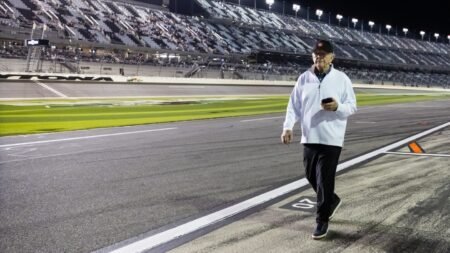To ensure the battles to reach the Championship 4 are on the level at Martinsville Speedway this weekend, NASCAR will bulk up the staff at its remote race control.
The new facility at NASCAR Productions in Concord, North Carolina, is overseen by former Cup Series director Scott Miller, who has a bank of state-of-the-art monitors with real-time audio, data and video to provide support to officials at the track who are making the decisions on competition and scoring.
The remote race control was in the final stage of completion last year during the Cup Series‘ Round of 8 finale, which resulted in massive penalties to several teams and drivers for manipulating the Nov. 3, 2024 race at Martinsville.
With its top three national series determining their championship foursomes Friday through Sunday at Martinsville, NASCAR will have more eyes and ears at its disposal in the remote race control than ever.
“It’ll be more built out than it has been at any point,” NASCAR managing director of communications Mike Forde said. “We’re going to have more officials helping Scott. Typically, we have three or four. This weekend, we’ll have several more. We’re not going to have 40 officials in there, but we are going to have a lot more and with the ability to scan (team radio channels).”
Forde said NASCAR‘s on-site officials already have leaned on the remote race control during the playoffs, noting that a request was sent to Miller from senior VP of racing development John Probst in the Talladega Superspeedway scoring tower for help with monitoring team radios Sunday.
“We’ll have several more officials being able to listen to more radios at the same time, so that’s the plan for this weekend,” Forde said. “We’ll also have some of our backup race directors listening to the scanners as well, so we’re going to have most hands on deck this weekend for all three races.”
NASCAR added new language to its 2025 rule book to address manipulation in greater detail and added a new penalty structure to punish manufacturers for altering race outcomes. Crew chiefs also have been warned about improper radio communication during the playoffs.
“Cutoff races are where you see it the most,” Forde said. “We’ll be on high alert this weekend, and hopefully, it won’t matter. I think the message that we delivered to crew chiefs in all three series is that if you’re talking about points, and it’s your car, and that communication is about trying to get your driver the best finish possible in that event, then you’re good to go. You have no problems. It’s when you start talking about other positions is where our ears are going to perk up.”
During the podcast, Forde and NASCAR senior director of racing communications Amanda Ellis also were joined by NASCAR managing director of track development Jerry Kaproth to discuss the unveiling of the street course layout at Naval Base Coronado in San Diego.
Other topics covered by Forde and Ellis during the 38th episode of “Hauler Talk,” which explores competition issues in NASCAR:
— How NASCAR handles a caution during a green-flag pit cycle, such as Shane van Gisbergen‘s spin entering the pits at Talladega.
— Why drying the weepers at Talladega was so difficult and what might be done in the future.
— The response time to the scene of a crash involving AJ Allmendinger at Talladega.
— Ty Dillon‘s penalty for striking Josh Berry‘s tire while exiting his pit stall.
— A new left-side tire for Martinsville Speedway.
Click on the embed above to listen or search for “Hauler Talk” wherever you download podcasts to hear it on your phone, tablet or mobile device.
Nate Ryan has written about NASCAR since 1996 while working at the San Bernardino Sun, Richmond Times-Dispatch, USA TODAY and for the past 10 years at NBC Sports Digital. He is a contributor to the “Hauler Talk” show on the NASCAR Podcast Network. He also has covered various other motorsports, including the IndyCar and IMSA series.
Read the full article here











